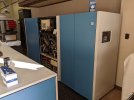I need to provide a network drive for an SME with 100 TB usable capacity. I would like to use a ZFS raid-z3 pool consisting of 14x 12TB SAS or SATA drives (this will be a rare-write/many-reads situation).
I have been looking at chassis like the
SuperMicro SC846BE1C-R1K03JBOD. Given that I'll run ZFS on this I don't want a raid controller but merely an HBA. Supermicro lists the
AOC-SAS3-9300-8E as a supported HBA.
I could not find this exact model number listed in the
hardware notes of FreeBSD 13.0. Is that gonna be a problem?
Is there any reason to believe that an LSI HBA officially supported by FreeBSD would not work in a chassis like this?
Now, I never worked with those JBOD chassis before. As I understood, I slap in the HBA, tons of drives and connect this chassis to an application server. Does something like this work out of the box? Will the application server (also FreeBSD 13.0) just see those drives as individual drives and I can create a ZFS pool like I am used to with "local drives"?
How does the (physical) connection to the application server work? Do I just add another HBA with external SAS ports to it, connect it to the external SAS ports of the HBA in the JBOD chassis and that's it?
Anything else you'd like to share in terms of advice, experience or similar?







